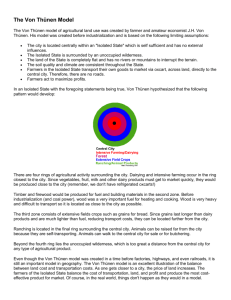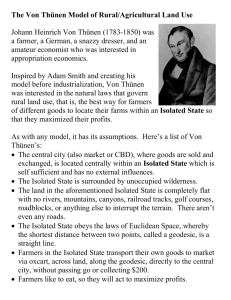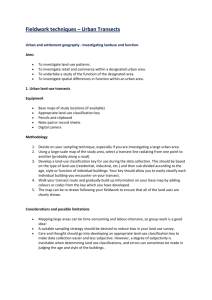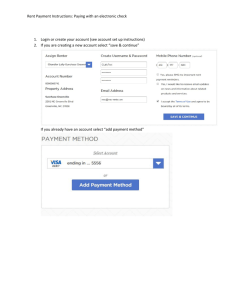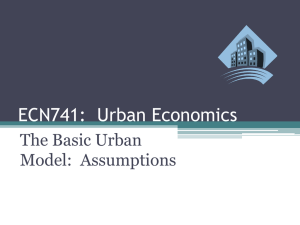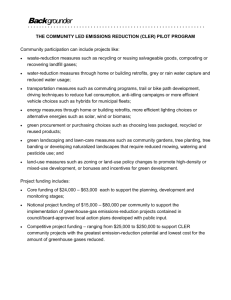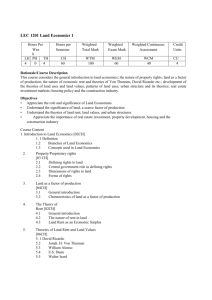Von Thünen model exercise - Feweb
advertisement
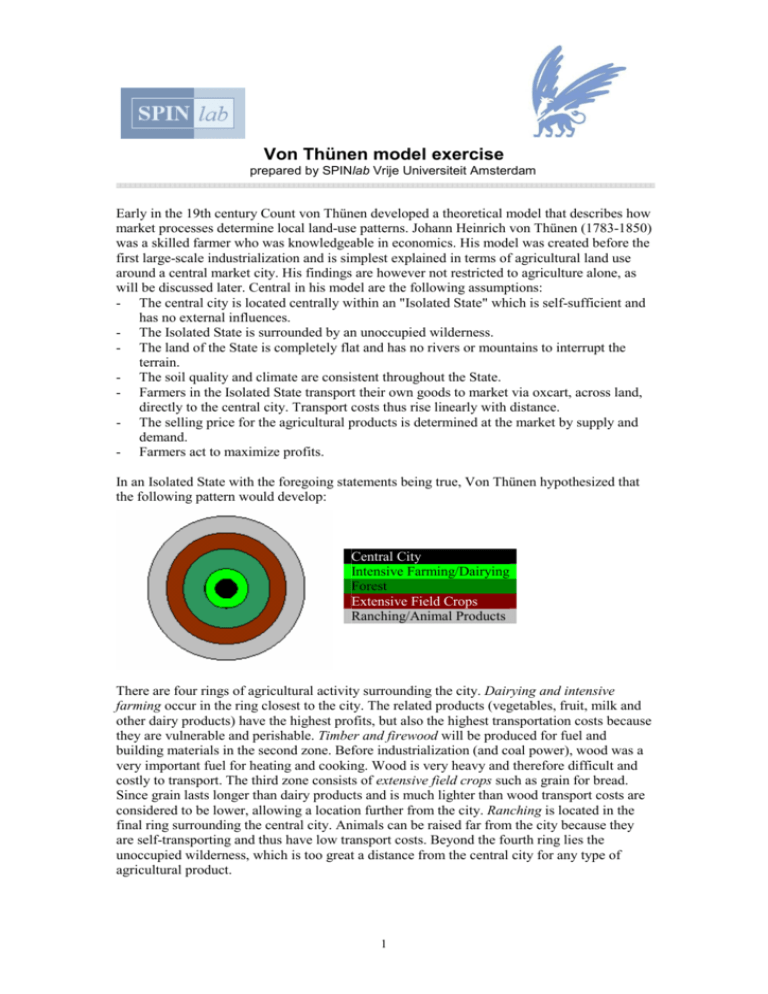
Von Thünen model exercise prepared by SPINlab Vrije Universiteit Amsterdam Early in the 19th century Count von Thünen developed a theoretical model that describes how market processes determine local land-use patterns. Johann Heinrich von Thünen (1783-1850) was a skilled farmer who was knowledgeable in economics. His model was created before the first large-scale industrialization and is simplest explained in terms of agricultural land use around a central market city. His findings are however not restricted to agriculture alone, as will be discussed later. Central in his model are the following assumptions: - The central city is located centrally within an "Isolated State" which is self-sufficient and has no external influences. - The Isolated State is surrounded by an unoccupied wilderness. - The land of the State is completely flat and has no rivers or mountains to interrupt the terrain. - The soil quality and climate are consistent throughout the State. - Farmers in the Isolated State transport their own goods to market via oxcart, across land, directly to the central city. Transport costs thus rise linearly with distance. - The selling price for the agricultural products is determined at the market by supply and demand. - Farmers act to maximize profits. In an Isolated State with the foregoing statements being true, Von Thünen hypothesized that the following pattern would develop: Central City Intensive Farming/Dairying Forest Extensive Field Crops Ranching/Animal Products There are four rings of agricultural activity surrounding the city. Dairying and intensive farming occur in the ring closest to the city. The related products (vegetables, fruit, milk and other dairy products) have the highest profits, but also the highest transportation costs because they are vulnerable and perishable. Timber and firewood will be produced for fuel and building materials in the second zone. Before industrialization (and coal power), wood was a very important fuel for heating and cooking. Wood is very heavy and therefore difficult and costly to transport. The third zone consists of extensive field crops such as grain for bread. Since grain lasts longer than dairy products and is much lighter than wood transport costs are considered to be lower, allowing a location further from the city. Ranching is located in the final ring surrounding the central city. Animals can be raised far from the city because they are self-transporting and thus have low transport costs. Beyond the fourth ring lies the unoccupied wilderness, which is too great a distance from the central city for any type of agricultural product. 1 The economic rationale behind the model is described in terms of profit and distance from the market. The profit consists of the (fixed) selling price minus the (fixed) production costs minus the (variable) transportation costs. The transportation costs increase linearly with distance. The descending curves below represent the profit for a product at a certain distance from the city. At distance D from the city, it becomes more profitable to produce product 2. Originally Von Thünen’s model was only concerned with location. However, it is possible to derive the land rent from this model. The farmers that grow a particular product prefer to locate closer to the city, as their profit will be higher. Thus for land closer to the city, they are willing to pay a rent, the land rent, which is at most the profit they make at that location. The conclusion is that land closer to the city will have a higher price than land that is located further from the city. In this simplified approach we state that land rent at a location will be equal to the local profit, being defined as: R = Y * (P-Cp) – Y * ( Ct * d), in which: R Y P Cp Ct d = land rent ( $/acre) = yield (ton/acre) = market price ($/ton) = production cost ($/ton) = transportation cost ($/ton/miles) = distance from town (miles) Even though the Von Thünen model was created in a time before factories, highways, and even railroads, it is still an important model in geography. The Von Thünen model is an excellent illustration of the balance between land cost and transportation costs. The farmers of the Isolated State balance the cost of transportation and land versus profit and produce the most cost-effective product for the market. The original simplifying assumption of a homogeneous “featureless” plane in which the central city is located received a lot of criticism. Many deemed the resulting concentric landuse patterns as being much too simple. The model can however easily be adopted to include roads and rivers that might decrease transportation costs to some locations. The following exercise allows you to play around with that adapted version of the Von Thünen model. 2 Exercise Please start the exercise by filling in the names and student numbers of your group members: Name Student number The Von Thünen software is available on the CD. Start the program by double-clicking on the thunen.exe file. This software essentially provides you with a blank homogeneous landscape on which a central market is placed. You can then use the drawing tools in the Design mode to add more towns, transport routes, rail routes and non-productive land which acts as constraints on the distribution of land uses. If there would be no constraints on land use, the model generates a symmetrical land-use pattern around the central town. The land-use pattern depends on how the Market price and Transport cost for each product are defined; these can be altered by using the sliders. The interaction of market price and transportation cost is presented in a land rent curve. You can then display the Land use map and look at the connected land rents in 3D surface Rent map. You can adjust the presentation of the surface by using the sliders. Question 1: Design your own landscape and calculate the land-use pattern for that landscape. Then change the transport costs of milk as a result of a new, cheaper technology to transport milk by large trucks. A) How do these decreased transport costs potentially affect the land-use pattern? What impact do you expect on the market price of milk? ……………………………………………………………………………………………… ……………………………………………………………………………………………… ……………………………………………………………………………………………… Now change the market price of meat due to an increase in consumer demand. B) How does this affect the land-use pattern? ……………………………………………………………………………………………… ……………………………………………………………………………………………… 3 Question 2: Open the predefined Chicago scenario by going to the Design mode and selecting File -> Open -> Chicago.bmp. Take a brief look at the market prices and transport costs and view the land-use and rent maps. A) Are the land-use and rent map confirming your initial expectations? ……………………………………………………………………………………………… ……………………………………………………………………………………………… B) Please write down the total areas of each land-use type below. Milk Grain Livestock Total area (sq.miles) Woodland The transport cost weights for rail and river transport are currently set at fraction of 0.5 and 0.1 of overland transport. Transport by train and river is thus cheaper then overland transport by a factor 2 and 10 respectively. Now consider a large-scale investment in upgrading the existing rail tracks leading to an increased transport-capacity and reduced transport costs. Click on the Design label. Now, in Options ->Weightings, change the transport cost setting to train 0,1 to reflect this decrease in train transport prices. Please note that it may be necessary to enter this value with a comma (,) sign instead of the original dot (.), to prevent an annoying “invalid floating point” message. In that case it will also be necessary to change the river weight value from 0.1 to 0,1 C) How does the decreased train transport cost change the general land-use pattern? ……………………………………………………………………………………………… ……………………………………………………………………………………………… D) Please write down the adjusted total areas of each land-use type below. Can you explain these changed total areas? Milk Grain Livestock Woodland Total area (sq.miles) ……………………………………………………………………………………………… ……………………………………………………………………………………………… E) What is the most important change in the land rent map as caused by the decreased train transport cost? What motivation for the large-scale investment in the train-tracks can you derive from the observed change? ……………………………………………………………………………………………… ……………………………………………………………………………………………… 4 Question 3: The Von Thünen model is of course an oversimplification of reality. Mention two important limitations of this land-use model. 1)...……………………………………………………………………………………………… 2)...……………………………………………………………………………………………… William Alonso extended the Von Thünen model in his book Location and Land Use (1964) and put it in an urban context. The central market town in the Von Thünen model is interpreted by Alonso as a city with a Central Business District (CBD) in the city centre. Households must commute there in order to work in the CBD. Again transportation costs are considered the main explanatory factor in the location decision of households and enterprises. This so-called bid-rent function approach now forms the basis of all contemporary theories on land use and land values. Bid-rent functions are typically formulated as follows: A household is supposed to spend its income on three things:1) land, 2) transportation costs and 3) all other goods. The household requires a location in a simplified city, which is monocentric, uniform, and in which markets are competitive. Employment, goods, and services are only available in the city centre. For an individual household the prices of land are given. Land prices are supposed to decrease with increasing distance from the city centre, which is “essentially true for most cities” and a requirement for the market equilibrium. Consequently a household has to decide how much of its income will be spend on land, how much on transportation costs, and how much on other goods. This decision is affected by the size of a parcel that can be bought for a certain budget at a certain distance from the city centre. A household can rent a larger house (on a larger parcel) further from the city centre for the same budget as a smaller house near the centre. But the bigger house at a larger distance from the centre has the disadvantage of offering higher transportation (commuting) costs. This idea is incorporated in a bid price curve of a household. This is the set of prices for land the individual could pay at various distances while deriving a constant level of satisfaction. The rent is paid to landlords who are local monopolists and try to maximise the rents they receive. The bidding process leads to a static equilibrium, in which the bid rent function becomes the rent curve as depicted in the figure below (in the case of identical consumers). 5 The theory for business location is rather similar to that for household location. Instead of maximising satisfaction, businesses maximise profits and need to ship their final products and inputs to and from the market or harbour, railway station etc. (in the case of a monocentric city). The resulting rent curves for businesses will be similar to one shown for households. Overlaying the different rent curves for household residents and different types of businesses informs us on the hypothetical land-use distribution in a city. Question 4: Consider a city with three types of urban land use: residences, offices and industry. A) Which land-use type will, in your opinion, offer the highest rent for a location near the centre; or in other words which will have the steepest rent curve? And which will offer the lowest rent? ……………………………………………………………………………………………… ……………………………………………………………………………………………… The resulting land-use patterns will again show a concentric alteration of the different urban land-use types around the centre, B) Can you state an actual example of a city that reflects the concentric land-use pattern that would be the results of the relative rents that you mentioned above? ……………………………………………………………………………………………… ……………………………………………………………………………………………… Sources: Alonso,W. (1964), Location and Land Use. Cambridge, Mass: Harvard University Press. Buurman, J.J.G. (2003), Rural Land Markets, A spatial explanatory model, Ph.D Thesis, Vrije Universiteit, Amsterdam. Thünen, von J.H. (1826), Der Isolierte Staat in Beziehung auf Landschaft und Nationalökonomie. Trans. By C.M. Wartenberg (1966) Von Thünen’s Isolated State. Oxford: Pergamon Press. Vreeker, R., H.L.F. de Groot & E.T. Verhoef (2004), Urban Multifunctional Land Use: Theoretical and Empirical Insights on Economies of Scale, Scope and Diversity, Built Environment, 30 (4), pp. 289-307. The von thünen software has been written by Professor Philip Steadman’s team at the Open University UK for a course called “From Babylon to Singapore: The Technology of Cities”. 6
